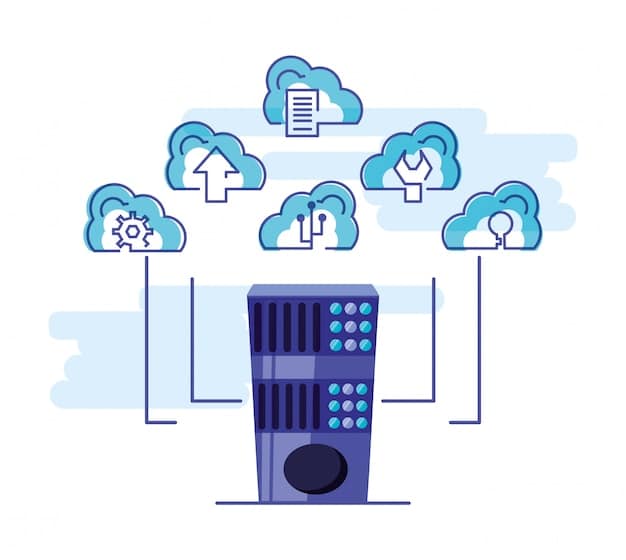E-commerce Scalability: Handling Holiday Traffic Surge in the US

E-commerce platform scalability is critical for US businesses to manage a 300% traffic increase during the holiday season by optimizing infrastructure, leveraging cloud services, and implementing efficient content delivery networks.
The holiday season is a make-or-break period for e-commerce businesses. Imagine your US-based online store suddenly experiencing a 300% surge in traffic. Is your platform ready? Understanding and implementing effective e-commerce platform scalability: how to handle a 300% increase in US traffic during the holiday season is crucial for survival and success.
Understanding the Importance of E-commerce Scalability
E-commerce scalability is about more than just keeping your website online. It’s about ensuring a seamless customer experience even when traffic spikes dramatically, especially during the holiday season. Without it, businesses risk losing revenue and damaging their reputation.
Why Scalability Matters During Peak Seasons
During the holidays, consumers are actively searching for deals and gifts. A slow or unresponsive website can quickly drive them away to competitors. Scalability ensures that your platform can handle the increased load without sacrificing performance.
The Cost of Inadequate Scalability
The consequences of not scaling effectively can be severe, ranging from lost sales and frustrated customers to long-term damage to your brand’s credibility. Ensuring your **e-commerce platform scalability: how to handle a 300% increase in US traffic during the holiday season** is ready avoids these issues.
- Lost Revenue: Downtime or slow loading times directly translate into lost sales.
- Customer Frustration: A poor user experience can deter customers from returning.
- Damaged Reputation: Negative experiences can lead to bad reviews and a loss of trust.

In conclusion, prioritizing e-commerce scalability is crucial for any US-based business anticipating a surge in traffic during the holiday season. It ensures a smooth customer experience, minimizes potential losses, and safeguards the company’s long-term reputation.
Assessing Your Current E-commerce Platform Capacity
Before the holiday rush arrives, it’s essential to thoroughly assess your current e-commerce platform’s capacity. Understanding its limitations and potential bottlenecks is the first step towards effective scalability.
Performance Testing and Load Simulation
Performance testing involves simulating real-world traffic conditions to identify how your platform performs under stress. Load simulation tools can help you mimic the expected surge in traffic to pinpoint areas that need improvement and to optimize your **e-commerce platform scalability: how to handle a 300% increase in US traffic during the holiday season**.
Identifying Potential Bottlenecks
Common bottlenecks include database overload, server capacity limitations, and inefficient caching mechanisms. Identifying these issues early allows you to address them proactively rather than reactively during peak season.
To accurately assess your platform’s capacity, consider the following:
- Conduct Load Testing: Simulate peak traffic to identify weak points.
- Monitor Server Performance: Track CPU usage, memory, and disk I/O.
- Analyze Database Performance: Identify slow queries and optimize database structure.
By thoroughly assessing your current e-commerce platform’s capacity and identifying potential bottlenecks, you can make informed decisions about the necessary upgrades and optimizations to ensure it can handle the anticipated holiday traffic surge.
Leveraging Cloud Services for Scalability
Cloud services offer a flexible and scalable solution for managing increased traffic during peak seasons. By leveraging cloud resources, businesses can easily scale their infrastructure up or down as needed, paying only for what they use.

Benefits of Cloud-Based E-commerce Platforms
Cloud-based platforms provide numerous advantages, including automatic scaling, high availability, and cost-effectiveness. This ensures your **e-commerce platform scalability: how to handle a 300% increase in US traffic during the holiday season** can scale.
Choosing the Right Cloud Provider
Selecting the right cloud provider (such as AWS, Azure, or Google Cloud) is crucial. Consider factors like pricing, performance, security, and available services to ensure the provider meets your specific needs.
When considering cloud services, keep these points in mind:
- Evaluate Scalability Options: Understand how each provider handles scaling.
- Assess Security Measures: Ensure the provider offers robust security features.
- Consider Cost Management: Develop a plan to control cloud costs during peak seasons.
In conclusion, leveraging cloud services offers a dynamic and cost-effective way to enhance e-commerce platform scalability, ensuring that businesses can handle traffic surges during the holiday season without sacrificing performance or incurring excessive costs.
Optimizing Website Performance
Optimizing website performance is crucial for providing a seamless user experience, especially during high-traffic periods. Simple actions can drastically improve your **e-commerce platform scalability: how to handle a 300% increase in US traffic during the holiday season**.
Image Optimization and Content Delivery Networks (CDNs)
Optimizing images by compressing them without sacrificing quality can significantly reduce page loading times. CDNs distribute your content across multiple servers globally, ensuring faster delivery to users regardless of their location.
Caching Strategies and Code Optimization
Caching frequently accessed data can reduce the load on your servers by serving cached content to users. Optimizing your website’s code can also improve performance by reducing unnecessary processing and improving efficiency.
To improve website performance, focus on the following strategies:
- Optimize Images: Compress images to reduce file sizes.
- Implement CDN: Use a CDN to distribute content globally.
- Leverage Caching: Cache frequently accessed data to reduce server load.
- Minify Code: Reduce the size of CSS and JavaScript files.
Optimizing website performance through image optimization, CDNs, caching strategies, and code optimization is essential for ensuring a fast and seamless user experience during the holiday season’s increased traffic.
Enhancing Database Efficiency
The database is a critical component of any e-commerce platform. Enhancing its efficiency is essential for maintaining performance and scalability, especially when dealing with a large influx of users.
Database Indexing and Query Optimization
Indexing improves query performance by allowing the database to quickly locate relevant data. Optimizing queries ensures that they are executed efficiently, minimizing the load on the database server.
Database Replication and Sharding
Database replication involves creating multiple copies of the database to distribute the load across several servers. Sharding involves partitioning the database into smaller, more manageable pieces, further improving performance and scalability.
To enhance database efficiency, consider these techniques:
- Implement Indexing: Add indexes to frequently queried columns.
- Optimize Queries: Rewrite slow queries for better performance.
- Use Replication: Create read replicas to distribute read traffic.
- Consider Sharding: Partition the database for scalability.
In conclusion, enhancing database efficiency through indexing, query optimization, replication, and sharding is vital for ensuring that your e-commerce platform can handle the increased load during the holiday season without compromising performance.
Monitoring and Incident Response
Effective monitoring and incident response are essential for maintaining a stable and reliable e-commerce platform. Real-time monitoring allows you to quickly identify and address issues before they impact users, ensuring your **e-commerce platform scalability: how to handle a 300% increase in US traffic during the holiday season** goes smoothly.
Real-time Monitoring Tools and Alerting Systems
Use monitoring tools to track key performance metrics such as server health, database performance, and website response times. Set up alerting systems to notify you of any anomalies or issues that require attention.
Creating an Incident Response Plan
Develop a detailed incident response plan that outlines the steps to take in the event of an outage or performance degradation. This plan should include clear roles and responsibilities, communication protocols, and escalation procedures.
To ensure effective monitoring and incident response, follow these steps:
- Implement Monitoring Tools: Use tools like New Relic, Datadog, or Prometheus.
- Set Up Alerts: Configure alerts for critical metrics.
- Create Response Plan: Define roles, communication, and escalation.
- Regularly Test Plan: Conduct drills to ensure readiness.
Monitoring and incident response are crucial components of maintaining a scalable and reliable e-commerce platform. These strategies ensure you can quickly identify and resolve issues during the holiday traffic surge, minimizing downtime and preserving customer satisfaction.
| Key Point | Brief Description |
|---|---|
| 🚀 Cloud Services | Leverage AWS, Azure, or Google Cloud for scalable infrastructure. |
| 🖼️ Image Optimization | Compress images to reduce page loading times and improve user experience. |
| 📊 Load Testing | Simulate peak traffic to identify weak points and optimize performance. |
| 🚨 Real-time Monitoring | Use monitoring tools to track key performance metrics and set up alerts. |
Frequently Asked Questions
▼
E-commerce scalability is crucial during the holidays because of the significant increase in traffic. Without it, websites may slow down or crash, leading to lost sales and dissatisfied customers looking to make a purchase.
▼
Cloud services like AWS, Azure, and Google Cloud offer on-demand scalability, allowing you to quickly increase resources to handle traffic spikes. This ensures smooth performance and a positive customer experience and keeps your **e-commerce platform scalability: how to handle a 300% increase in US traffic during the holiday season** primed.
▼
Common bottlenecks include overloaded databases, server capacity limitations, unoptimized code, and inefficient caching. Identifying and addressing these issues can significantly improve the performance of your platform is key.
▼
CDNs reduce the load on your main server by distributing static content (images, videos, etc.) across multiple servers worldwide. This ensures faster loading times for users, regardless of their geographic location improving performance for your **e-commerce platform scalability: how to handle a 300% increase in US traffic during the holiday season**.
▼
Database optimization is critical for e-commerce scalability because the database stores all product, customer, and order information. Improving database efficiency through indexing and query optimization ensures faster data retrieval and processing, improving overall platform performance.
Conclusion
Successfully navigating the holiday season’s traffic surge demands a proactive approach to e-commerce platform scalability: how to handle a 300% increase in US traffic during the holiday season. By understanding the importance of scalability, assessing your platform’s capacity, leveraging cloud services, optimizing performance, and implementing robust monitoring and incident response plans, businesses can ensure a seamless and profitable holiday season.





